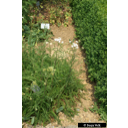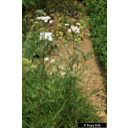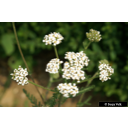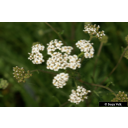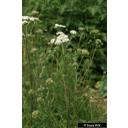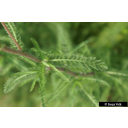Useful information about the taxon (species, subspecies, variety...)
Achillea millefolium L. 1753
Asteraceae (Compositae)
(APG IV)Akzessionnummer: HvB-694
Pflanzjahr: 0
Taxon concept: Global Compositae Database (TICA)
Achillea millefolium Ledeb. subsp. millefolium - Accepted: Achillea millefolium Ledeb. subsp. millefolium bei Zander 2008; Familie: Asteraceae (Compositae) (Zander 2008)Achillea millefolium Ledeb. subsp. millefolium - Synonym: Achillea millefolium L. bei The Plant List (2010); Familie: Asteraceae (Compositae) (APG III)Achillea millefolium L. - Accepted: Achillea millefolium L. bei The Plant List (2010); Familie: Asteraceae (Compositae) (APG III)Achillea millefolium L. - Accepted: Achillea millefolium L. bei The Plant List (2014), version 1.1; Familie: Asteraceae (Compositae) (APG III)Achillea millefolium L. - Accepted: Achillea millefolium L. bei The Plant List (2014), version 1.1; Familie: Asteraceae (Compositae) (APG IV)Achillea millefolium L. - Accepted: Achillea millefolium L. bei The Plant List (2010); Familie: Asteraceae (Compositae) (APG IV)Achillea millefolium L. - Accepted: Achillea millefolium L. bei Schmeil-Fitschen 2019; Familie: Asteraceae (Compositae) (APG IV)Achillea millefolium L. - Accepted: Achillea millefolium L. bei Rothmaler 2011; Familie: Asteraceae (Compositae) (APG IV)Achillea millefolium L. - Accepted: Achillea millefolium L. bei BfN Checklist Flora DE; Familie: Asteraceae (Compositae) (APG IV)Achillea millefolium L. - Accepted: Achillea millefolium L. bei World Flora Online - APG IV (Angiosperms); Familie: Asteraceae (Compositae) (World Flora Online - APG IV (Angiosperms))
- Color of flower
- white
- Life form
- herbaceous, terrestrial, perennial
Bundesamt für Naturschutz (BfN) (1999-2001 and ongoing): Floraweb - Daten und Informationen zu Wildpflanzen und zur Vegetation Deutschlands. www.floraweb.de.; Erhardt, W., Götz, E., Bödeker, N. & Seybold, S. (2008): Der große Zander. Enzyklopädie der Pflanzennamen. Band 2. Arten und Sorten. Eugen Ulmer KG, Stuttgart (Hohenheim), 18. Aufl., 2103 S.; Haider, M. et al. (2005): Wildbienenkataster. See: https://www.wildbienen-kataster.de; Kämper, Wiebke et al. (2018): Flower visitation honeybee and bumblebee. See: https://www.bexis.uni-jena.de/ddm/data/Showdata/16086?version=2; Ministerium für Ernährung, Landwirtschaft, Umwelt und Forsten, Baden-Württemberg (Hrsg.) (1985): Pflanzenkatalog zur Verbesserung der Bienenweide und des Artenreichtums (Kurztitel: Bienenweidekatalog); Oberdorfer, E. (2001): Pflanzensoziologische Exkursionsflora. Für Deutschland und angrenzende Gebiete. Eugen Ulmer Verlag, Stuttgart, 8., stark überarb. u. erg. Aufl, 1056 S. 978-3-8001-3131-0.; Parreno, Alejandra et al. (2025): Visitation records of bees in Germany (58 plots). See: https://www.bexis.uni-jena.de/ddm/data/Showdata/31131?version=12; Pritsch, Günter et al. (2007): 200 Trachtpflanzen erkennen und bewerten.. Kosmos, Stuttgart; Schick, B. & Spürgin, A. (1997): Die Bienenweide. Eugen Ulmer Verlag, Stuttgart, Auflage: 4., völlig neubearb. u. erw. A., 216 S. 978-3800174188.; The International Plant Names Index (2009). Published on the Internet http://www.ipni.org; Courtesy to IPNI, 2009. Exported from IPNI at date: 2009-09-22 20:17:51; Werle, Susanne et al. (2015): ITS2 DNA metabarcoding of wild bee pollen loads, collected in 2020 and 2021 across all three exploratories. See: https://www.bexis.uni-jena.de/ddm/data/Showdata/31545?version=6; Westrich, P. et al. (2018): Die Wildbienen Deutschlands.. Ulmer Verlag ISBN 978-8186-0123-2.;
Diese Webseite verwendet Google Maps, um Karten und Standorte von Pflanzen in den Hohenheimer Gärten anzuzeigen. Dadurch werden unter Umständen Daten an Google weitergeleitet, was mit einer Verarbeitung Ihrer personenbezogenen Daten verbunden sein kann. Die Datenschutzerklärung von Google finden Sie hier: Datenschutzerklärung von Google

